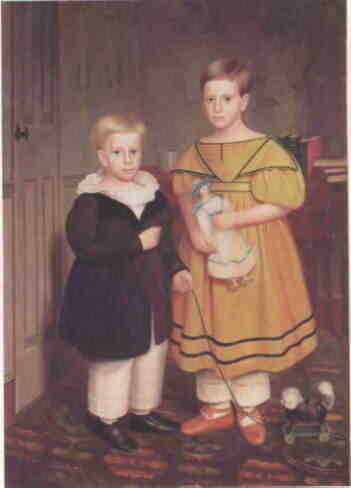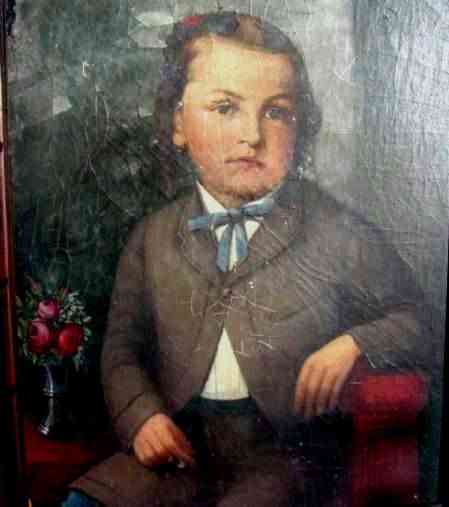
American Primitive Art: Ties and Bows

Figure 1.--This unidentified American primitive shows the pantalettes worn by young children with tunics and dresses. Some like these were plain, others were much more fancy. Notice the open ruffled collar worn without bows that were common in the early 19th century.
|
Many boys in the early 19th century wore open collar styles without neckwear. As the decade progressed various types of neckwear appeared. Boys tende to wear relatively small ties and bows, the large bows are a late 19th century style not seen in the first half of the century.
Open Collars
Many boys in the early 19th century wore open collar styles without neckwear. Boys from affluent families might wear heavily ruffled collars, but even so they look much more comfortable than boys in the later-19th century wearing large fancvy closed-necked collars.
Cravats
Stocks
Many boys at mid-century were wearing the stocks that were commonly worn by their fathers.
Bows
As the decade progressed various types of neckwear appeared. Boys tende to wear relatively small ties and bows, the large bows are a late 19th century style not seen in the first half of the century. By the 1830s bows were becoming more common, as boys began to more commonly wear closed-neck collars. The bows worn, however, were relatively small ones, nothing like the huge bows boys wore later in the century. The trends in American primative art during the first half of the 19th century chricle the gradual shift of boys clothing from looser, comfortable clothes to a more formal style increasingly less suitable for younger children.

Figure 2.--THe face on this portrait does not look quite right, almost as if it was painted from a photoraph--in relation to the rest of the painting which is more primitive. The boy wears the narrow ribbon tie now so associated with Western dress. HBC believes this may have been painte about 1850. Notice that this boy's tie is blue.
|
Ties
Boys at mid-century began wearing very narrow ribbon like ties, knoted in a "T", a style today associated with the West. In the 19th century, this Western association was not as strong.HBC begins tyo notice this style about the 1850s. HBC has note this style in some early photyographs and had assumed they were black. This style worn today with Western dress is usually black. Note that the boy pictured here wears a blue tie (figure 2).
Christopher Wagner

Navigate the Boys' Historical Clothing Artist pages:
[Return to the Anonymous primitive artist ]
[Return to the Main primitive artist page]
[Return to the Main style page]
[Blake]
[Johnson]
[Stock]
[Waters]
[Chronology]
[Countries]
[Individuals]
Navigate the Boys' Historical Clothing Web Site:
[Return to the Main dress page]
[Return to the Main bow page]
[Introduction]
[Activities]
[Bibliographies]
[Biographies]
[Chronology]
[Clothing styles]
[Contributions]
[Countries]
[Boys' Clothing Home]
Created: January 27, 2001
Last updated: January 27, 2001




